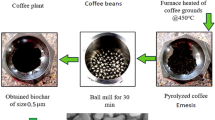Abstract
Experimental studies were conducted to investigate the microwave (MW) heating behavior of soda-lime glass beads with added iron powder. These studies were intended to obtain fundamental knowledge for vitrification solidification and for the fabrication of metal-reinforced glass-matrix composites. The glass beads (0.2 mm diameter) did not heat very well by themselves at temperatures greater than 200 °C within 600 s in a multimode applicator at a power of 0.67 W. The addition of iron powder (average 70 μm, volume fraction 18%) made it possible to heat the glass beads above 700 °C within 60 s. At lower fractions of 3–11 vol%, however, a sudden temperature rise [thermal runaway (TRW)] occurred after the incubation time period. A single-mode MW applicator was used for clarifying the electric (E)-field and magnetic (H)-field contributions to the heating of each material and their mixtures. The results of this study demonstrated that the H-field contributed to the heating of the iron and then triggered the heating of the glass. The E-field component is necessary for heating the glass to a temperature higher than 800 °C. The factors determining the threshold values of the volume fraction causing TRW are discussed.










Similar content being viewed by others
References
D.A. Jones, T.P. Lelyveld, S.D. Mavrofidis, S.W. Kingman N.J. Miles: Microwave heating applications in environmental engineering: A review. Resources Conserv. Recycl. 34, 75 2002
S.J. Oda: Dielectric processing of hazardous materials: Present and future opportunities in Microwave Processing of Materials III, edited by R.L Beatty, W.H. Sutton, and M.F. Iskander (Mater. Res. Soc. Symp. Proc. 269, Pittsburgh, PA, 1992), p. 453
J.A. Menéndez, A. Domínguez, M. Inguanzo J.J. Pis: Microwave-induced drying, pyrolysis and gasification (MWDPG) of swage sludge: Vitrification of the solid residue. J. Anal. Appl. Pyrolysis 74(1-2), 406 2005
T. Hua-Shan G.J. Chih-Ju: Immobilization of chromium-contaminated soil by means of microwave energy. J. Hazard. Mater. 65(3), 267 1999
L. Dauerman, G. Windgasse, H. Gu, N. Ibrahim E.H. Sedhom: Application of microwave treatment of hazardous wastes: a) Non-volatile organics; b) Heavy metals in Microwave Processing of Materials II, edited by W.B. Snyder, Jr., W.H. Sutton, M.F. Iskander, and D.L. Johnson (Mater. Res. Soc. Symp. Proc. 189, Pittsburgh, PA, 1991), p. 61
K. Morita, V.Q. Nguyen, R. Nakaoka J.D. Mackenzie: Immobilization of ash by microwave melting in Microwave Processing of Materials III, edited by R.L Beatty, W.H. Sutton, and M.F. Iskander (Mater. Res. Soc. Symp. Proc. 269, Pittsburgh, PA, 1992), p. 471
R.A. Abramovitch, L. Chang-Qing, E. Hicks J. Sinard: In situ remediation of soils contaminated with toxic metal ions using microwave energy. Chemosphere 53, 1077 2003
E.J. Minay, P. Veronesi, V. Cannillo, C. Leonelli A.R. Boccaccini: Control of pore size by metallic fibres in glass matrix composite foams produced by microwave heating. J. Eur. Ceram. Soc. 24, 3203 2004
E.J. Minay, A.R. Boccaccini, P. Veronesi, V. Cannillo C. Leonelli: Processing of novel glass matrix composites by microwave heating. J. Mater. Proc. Technol., 155–156(30), 1749 2004
D. Clark W.H. Sutton: Microwave processing of materials. Annu. Rev. Mater. Sci. 26, 299 1996
W.D. Kingery, H.K. Bowen D.R. Uhlmann: Introduction to Ceramics 2nd ed. John Wiley and Sons New York 1975
R. Roy, R. Peelamedu, L. Hurtt, J. Cheng D. Agrawal: Definitive experimental evidence for microwave effects: Radically new effects of separated E and H fields, such as decrystallization of oxides in seconds. Mater. Res. Innovat. 6, 128 2002
J. Cheng, R. Roy D. Agrawal: Experimental proof of major role of magnetic field losses in microwave heating of metallic composites. J. Mater. Sci. Lett. 20, 1561 2001
N. Yoshikawa, E. Ishizuka S. Taniguchi: Heating of metal particles in a single-mode microwave applicator. Mater. Trans. 47(3), 898 2006
Committee on Microwave Processing of Material: Microwave processing of materials in An Emerging Industrial Technology edited by Committee on Microwave Processing of Material National Academy Press Washington, DC 1994 36
V.M. Kenkre, L. Skala M.W. Weiser: Theory of microwave interactions in ceramic materials: The phenomenon of thermal runaway. J. Mater. Sci. 26, 2483 1991
A.R. Von Hippel: Dielectric Materials and Applications MIT Press Cambridge, MA 1954 404
Author information
Authors and Affiliations
Corresponding author
Rights and permissions
About this article
Cite this article
Yoshikawa, N., Wang, H., Mashiko, Ki. et al. Microwave heating of soda-lime glass by addition of iron powder. Journal of Materials Research 23, 1564–1569 (2008). https://doi.org/10.1557/JMR.2008.0190
Accepted:
Published:
Issue Date:
DOI: https://doi.org/10.1557/JMR.2008.0190




